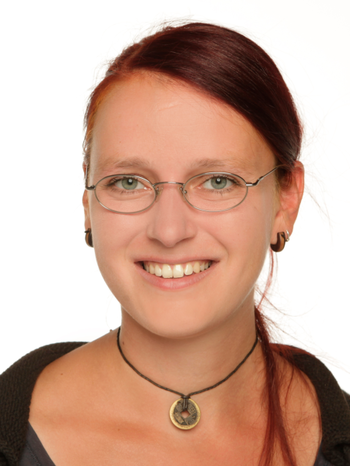Dipl.-Restauratorin Antonia Höhne

Ancient Objects and Visual Studies (AOViS)
Ancient Near Eastern Archaeology
Institut für Vorderasiatische Archäologie
Fabeckstraße 23–25
14195 Berlin
Ausbildung
09/03 – 02/08
Studium an der Fachhochschule für Technik und Wirtschaft Berlin; Studiengang Restaurierung/ Grabungstechnik; Spezialisierung im Fach Restaurierung von archäologischem und historischem Kulturgut;
Diplomarbeit zu dem Thema: "Ein Schapel aus dem hochmittelalterlichen Lübeck. Untersuchung und Restaurierung eines altrestaurierten Kompositobjektes."
Beruflicher Werdegang
06/10 – 06/12
Projektmitarbeiterin bei "IMPACT" an der HTW Berlin, Forschungsgruppe Kulturerbe; Analysen und Dokumentation von Kulturgut mittels p-ED-RFA, FTIR, TGA, digitaler Röntgenanlage, 3-D-Laserscan-Geräten, Magnetometer und GPS-gestütztem Tachymeter
05/08 – 05/10
Technische Assistentin in der archäobotanischen Abteilung des Institutes für Ur- und Frühgeschichte der Christian-Albrechts-Universität, Kiel
Seit 04/08
Tätigkeit als freiberufliche Restauratorin für archäologische Objekte und Möbel in Berlin
Praktika und Projekte
09/2010
Teilnahme an der Restaurierungs- und Dokumentationskampagne auf der Zitadelle in Aleppo, Syrien; Restaurierung und Analyse (p-ED-RFA) von archäologischen Funden
09/2009 + 09/2011
Teilnahme an der Grabungskampagne im Rahmen des DFG- Projektes "Rekonstruktion spätneolithischer Siedlungsprozesse in Zentralbosnien" in Jagnilo (nahe Goražde), BiH; Projekt des Institutes für Ur- und Frühgeschichte der CAU, Kiel
05/2007 + 05/2008 + 05/2009 + 05/2010
Restaurierung und Dokumentation von spätneolithischer Keramik im Nationalmuseum Sarajewo, BiH, im Rahmen der Grabungskampagnen in Okolište und Jagnilo, BiH; Projekt des Institutes für Ur- und Frühgeschichte der CAU, Kiel
09/2005 + 09/2006 + 09/2008
Teilnahme an Grabungskampagnen zur Untersuchung eines neolithischen Tells in Okolište, BiH; Projekt des Institutes für Ur- und Frühgeschichte der CAU, Kiel
04/2007 – 04/2010
Restaurierungsarbeiten in einem Grabungsprojekt zur Untersuchung einer frühbronzezeitlichen Siedlung in Bruszczewo, PL, des Institutes für Ur- und Frühgeschichte der CAU, Kiel
07/2006 – 08/2006
Praktikum im Rahmen des Praxissemesters in der archäologischen Abteilung der Universität von Ljubljana, Slowenien; Restaurierung von eisenzeitlicher Keramik aus einem Grabkomplex; Betreuung durch Prof. Dr. B. Teržan
06/2006
Praktikum im Rahmen des Praxissemesters im Museum Visoko, BiH; Restaurierung von spätneolithischer Keramik
03/2006 – 04/2006
Praktikum im Rahmen des Praxissemesters in den Restaurierungswerkstätten des Schloss Gottorf, Archäologisches Landesamt von Schleswig- Holstein
11/2002 – 08/2003
Studienvorbereitendes Praktikum im Rathgen-Forschungslabor der Staatlichen Museen Berlin Stiftung Preußischer Kulturbesitz (Archäometrie); Betreuung durch Prof. Dr. Riederer
Die Differenzierung eines umfangreichen Keramikkomplexes aus dem mittleren Euphrattal mithilfe der p-ED-RFA unter Einbeziehung technologischer Merkmale zur Rekonstruktion von Distributionssystemen früherer Gesellschaften
Within the framework of the dissertation project, a comprehensive spatial and chronologically broad-spread ceramic material will be used to examine the extent to which conclusions on the change, both of manufacturing techniques, manufacturing intentions, the raw materials used, and distribution patterns of technologies in a diachronic perspective are possible using the portable energy-dispersive X-ray fluorescence analysis (p-ED-XRF) and by which methods they have to be supplemented if necessary.
The aim of the planned work is to find appropriate measuring parameters for the application of the p-ED-XRF using ceramics of a survey carried out in Syria, and to compare it with the informational value of “conventional” examination methods.
Basically, it should be clarified to what extent comprehensive survey ceramic complexes can be differentiated using the p-ED-XRF and the incorporation of technological characteristics in order to be able to make conclusions on the development of production and distribution systems of ancient societies.
In order to determine whether the p-ED-XRF is suitable as a method for the chemical differentiation of the ceramics in the investigation area and thus for the identification of locally produced fabrics, a random sample was selected which spatially and chronologically represents the entire work area. The ceramic fragments were analyzed using the p-ED-XRF as well as with the more accurate wavelength-dispersive XRF and the obtained data on the element content were evaluated statistically. Therefore, the p-ED-XRF could be evaluated with regard to the determination of the optimal measurement duration, the effects of sample preparation and the representativeness of individual measurements and the measurement precision. As a result, it was found that the ceramic material can be chemically differentiated only relatively roughly, which could most probably explained by the geological conditions in the middle Euphrates Valley. The lower accuracy of the p-ED-XRF compared to established laboratory methods also confounds that pattern.
After this primary methodological approach was evaluated and it was found that this alone is improper to answer the question of the project satisfactorily, the focus was now particularly on the detailed recording of the technological characteristics of the ceramics in a database and the statistical evaluation to investigate the morphological, technological and metric variability of the complex. Material from four time slices (Ubaid to Middle Bronze Age) was chosen to compare these data both synchronously and diachronically. With the recorded data on the ceramics of the first two time slices, first evaluation strategies could now be developed, which are still being further developed.
Results
First results will be published in an article soon: Antonia Hofmann: Evaluation and calibration of the p-ED-XRF analyser “Tracer” (Co. Bruker) for classifying pottery from the middle Euphrates in comparison with WD-XRF-results. In: Application of portable energy-dispersive x-ray-fluorescence to the analysis of archaeological ceramics, TOPOI. Berlin Studies of the Ancient World.
The thesis is being written within the Research Group A-6 Economic Space of the Excellence Cluster 264 Topoi.
2013
"Neue Perspektiven – Untersuchung archäologischer Objekte mittels portabler ED-Röntgenfluoreszenzanalyse", in: "Beiträge zur Erhaltung von Kunst- und Kulturgut, Schriftreihe des VdR", 2/2013.
Robert und Antonia Hofmann: "Anthropomorphe und zoomorphe Figurinen des Spätneolithikums aus Okolište und der Butmirgruppe in Zentralbosnien – Darstellungsmodi, Datierungen, Häufigkeiten, Herstellungstechniken und Fundkontexte."
